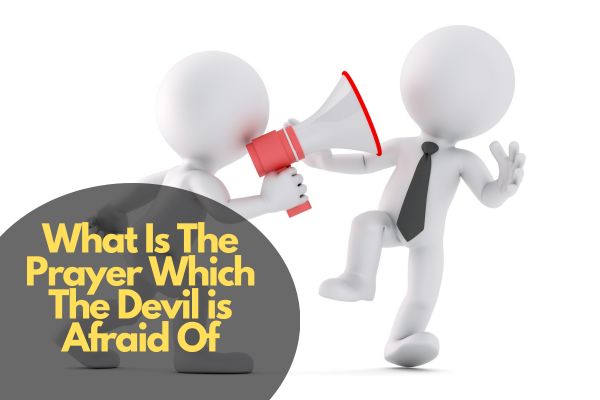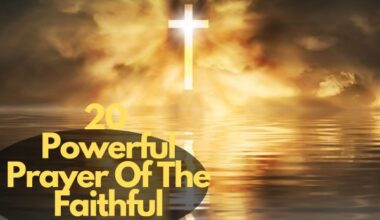Table of Contents Show
In the tapestry of religious beliefs, the phrase “What Is The Prayer Which The Devil is Afraid Of” echoes with a mystical resonance. This article explains the enigmatic world of this prayer, unveiling its secrets and exploring its profound impact on believers worldwide.
What Is The Prayer Which The Devil is Afraid Of
The phrase “the prayer which the Devil is afraid of” holds a mysterious allure, transcending boundaries of culture, faith, and time. In the diverse tapestry of religious beliefs, this prayer stands out as a beacon of protection against evil forces. Understanding its origins, interpretations, and significance is crucial for believers worldwide.
Historical Significance
This ancient incantation finds its roots in centuries-old scriptures and texts. Its origins are shrouded in mystery, yet its potency has been revered across diverse cultures. Exploring these origins provides a fascinating glimpse into the spiritual heritage of humanity.
Throughout history, texts and scriptures from various religions have referenced the prayer that instills fear in the Devil. Ancient tales and religious anecdotes echo the power of this prayer, narrating incidents where its utterance brought divine intervention and shielded believers from malevolent entities.
Interpretations Across Religions
Different religions embrace diverse perspectives on this prayer. In Christianity, it’s often associated with the concept of divine intervention, whereas in Islam, it symbolizes submission to Allah’s will. Buddhists perceive it as a path to enlightenment, highlighting the prayer’s versatile interpretations across faiths.
The Power of the Prayer
Beyond the surface, the prayer holds profound spiritual significance. Believers share awe-inspiring stories of its transformative power. In times of distress, invoking this prayer is believed to provide solace, strength, and protection, acting as a shield against the Devil’s influence.
Protection Against Evil
One of the prayer’s primary attributes is its protective quality. Devotees across cultures employ this prayer as a shield against evil entities and negative energies. Rituals and traditions associated with the prayer vary, but the common thread is the belief in its ability to repel the Devil’s sinister schemes.
Cultural and Regional Variations
Interestingly, the prayer takes on unique forms across cultures and regions. From rituals in remote villages to grand ceremonies in bustling cities, the prayer’s essence remains, though customs and practices surrounding it differ. Exploring these variations provides a glimpse into the rich tapestry of human spirituality.
Common Misconceptions
Despite its revered status, the prayer is not immune to misconceptions. Myths and false beliefs often shroud its true essence. Addressing these misconceptions is vital, as it allows believers to approach the prayer with genuine faith and understanding, untainted by misinformation.
Historical Context and Evolution
Tracing the prayer’s origins reveals a fascinating journey through time. Its evolution, intertwined with the evolution of religious thought, showcases how meanings and practices have transformed over centuries. Exploring this historical context sheds light on the prayer’s enduring appeal.
Impact on Believers’ Lives
Real-life stories underscore the prayer’s impact on believers. Tales of miraculous healings, deliverance from adversity, and profound spiritual experiences abound. Religious leaders and scholars also attest to the prayer’s influence, emphasizing its role in shaping believers’ lives and fostering unwavering faith.
Theological Perspectives
Theological interpretations enrich our understanding of the prayer. Scholars delve into religious texts, dissecting verses and analyzing historical contexts to unveil deeper meanings. Comparing these perspectives provides a comprehensive view, illustrating the prayer’s intricate theological significance.
Contemporary Relevance
In our fast-paced, interconnected world, the prayer’s relevance remains undiminished. Its teachings resonate with contemporary challenges, offering solace amidst chaos. Modern applications, such as mindfulness practices and meditation techniques, draw inspiration from the prayer, demonstrating its enduring relevance.
Critiques and Debates
No religious concept is immune to scrutiny. The prayer, too, faces critiques and debates within religious circles. Scholars engage in discussions about its authenticity, debating interpretations and exploring its relevance in the modern age. Acknowledging these debates fosters a nuanced understanding of the prayer.
Practical Guide
For believers seeking to incorporate prayer into their spiritual lives, a practical guide is essential. Simple steps, such as mindful recitation and understanding the prayer’s core message, can empower individuals. Harnessing the prayer’s power requires genuine intent, faith, and a willingness to embrace its teachings.
Impact on Society
Beyond individual spirituality, prayer influences societal norms and values. Communities that uphold the prayer’s teachings often prioritize compassion, empathy, and social justice. By promoting these values, prayer contributes to the creation of harmonious societies, transcending religious boundaries.
Conclusion
In a world rife with challenges and uncertainties, the prayer that the Devil is afraid of stands as a beacon of hope and protection. Its universal appeal, rooted in diverse religious traditions, emphasizes the human need for spiritual connection and divine guidance. Understanding its historical significance, interpretations, and practical applications enriches our spiritual journey, inspiring a sense of awe and reverence.
Frequently Asked Questions (FAQs)
- Q: Is the prayer that the Devil is afraid of specific to a particular religion?A: No, the prayer transcends religious boundaries and is found in various forms across different faiths.
- Q: Can anyone recite the prayer, or are there specific conditions for its effectiveness?A: The prayer is accessible to anyone, regardless of their background or beliefs. Sincerity and faith are key to its effectiveness.
- Q: Are there historical accounts of the prayer’s impact on individuals or communities?A: Yes, historical texts and religious scriptures contain numerous accounts of the prayer’s positive influence on believers’ lives and communities.
- Q: How can one incorporate prayer into their daily spiritual practice?A: Incorporating the prayer can be as simple as regular recitation, accompanied by understanding its meaning and significance. Many believers also incorporate it into meditation or mindfulness practices.








